All year, I’ve been waiting for the moment I could finally share about the magic that my friend and fellow artist, Nicki Cherry, has brought to this year’s season of Chores — launching December 9, 2024 at 12pm EST.
To the world at large, Nicki (they/them) is an accomplished sculptor whose strange, corporeal, and awkwardly beautiful forms wrestle with themes as bold as they are tender. To me, they are a treasured friend who goes way, way back — to a time when neither of us knew we were going to be artists.
Nicki and I met over ten years ago as undergraduate students at the University of Chicago. They were a physics major who didn’t yet realize they needed to be a visual arts major, and I was busy sewing my very first garments in the theater department’s costume shop when I should have been locked in the library.
Over the last decade, we’ve both been on somewhat chaotic journeys of learning how to integrate creative practice with everyday life, and I’ve gotten to watch Nicki transform step by earnest step into the incredible artist they are today — making work that never fails to speak to parts of my heart that long to feel so understood.
I already knew when Nicki came by last year’s exhibition of Chores Collection 2, Season 1 that I wanted to ask them to work on this year’s collection with me. What they made for Collection 2, Season 2 was beyond what I had imagined, yet nothing short of what I’ve come to expect from their unique artistry.
Below is a short conversation we recorded as we wrapped up this collaboration. We hope you enjoy, and stay tuned for the collection showcase and launch in December.
A most heartfelt thank you to Nicki for bringing so much of their tender heart to this project, and to Echo Yun Chen for her beautiful photos, both above and below.
In conversation with Nicki Cherry
09/26/24
Joy: When we started this collaboration back in… January?? Ages ago! The “brief” I gave you was really quite simple — can you create ten sculptural elements for each of the ten coats, about the size of your thumb or smaller, perhaps made of silver, perhaps made detachable? Aside from general size/material guidelines, I was super open to how you might interpret the challenge. How did you feel about it all as we were getting started?
Nicki: I was really excited by the brief, but a little nervous! I’m used to working big — “small” usually means tabletop-sized for me. I’m so used to relating to my sculptures by walking around them that it felt very foreign to make something I could consider in the palm of my hand. Feeling your trust in me helped to ease that anxiety.
Nicki: Our first idea was making lockets. When you first shared the theme of “twoness” for this season, I thought about the intimacy generated through sharing secrets with friends. Lockets felt like a natural reference to that relationship — a vessel pressed against our skin that tenderly holds something we very selectively share. While I ended up abandoning the locket functionality, I hope the charms still hold the sense of closeness formed out of revealing ourselves to others.
Joy: I loved the idea of lockets when you first mentioned it, but also thought you were nuts. You’d never worked so small before… never worked with silver before… told me you were gonna get a blow torch (!!)… I was just like, how are you going to learn how to construct such an intricate object, with unfamiliar materials, while juggling a bunch of your own shows, in just a month or so before we needed to start making the actual pieces??
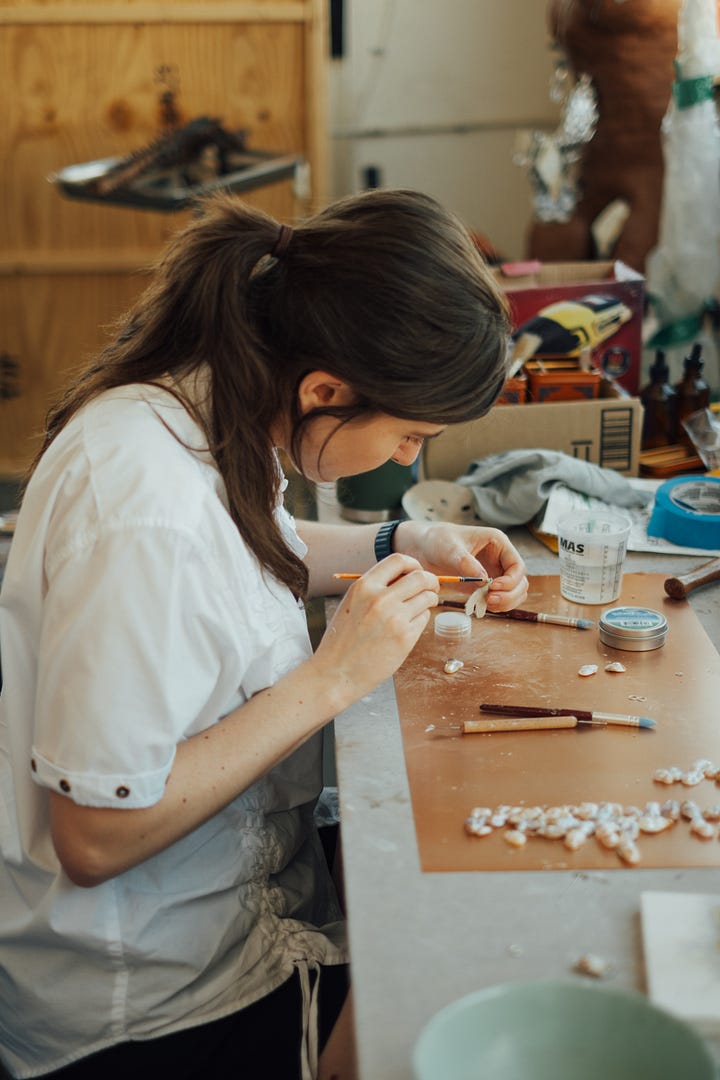
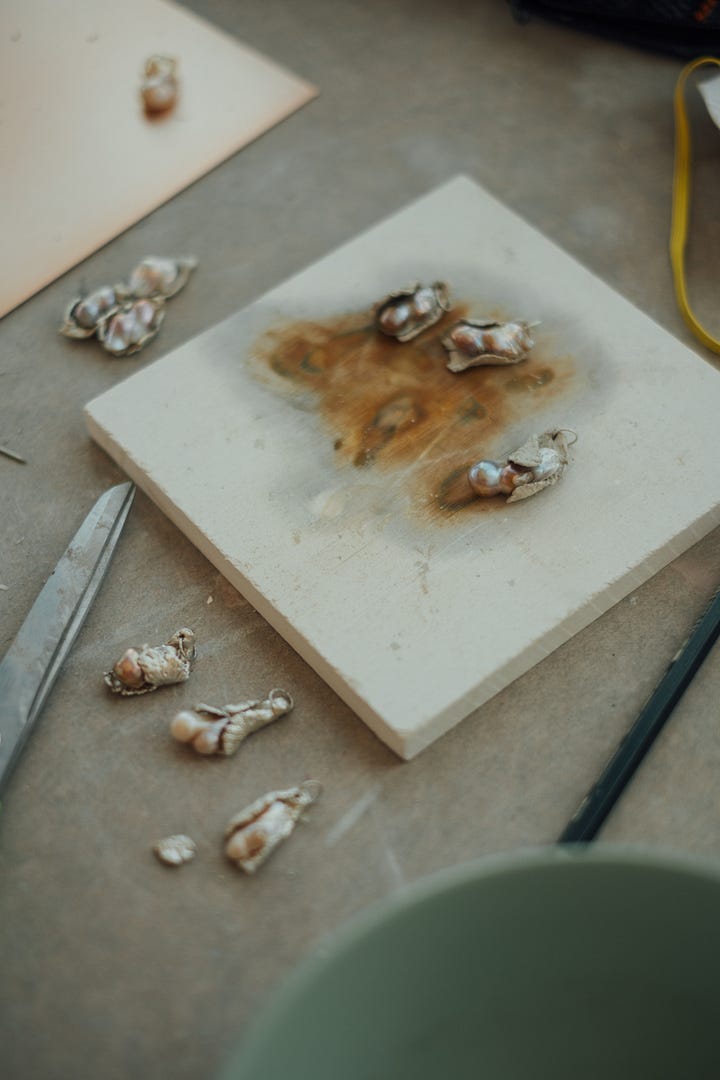
Joy: But I’ve always been really impressed with your ability to learn new things in seemingly no time, and your willingness to see the potential in materials that may be a bit unpredictable or unconventional. Could you tell us a bit about the pearls?
Nicki: My eyes are always bigger than my stomach in the studio! Sometimes the failed attempts of hitting an unrealistic goal end up being way more interesting than the original idea.
The pearls in the charms are a variant called blister pearls. They’re formed directly on the shell and have to be cut out, so you can see where the shell and pearl met. A lot of them appear to have two pearls enveloped together in a nacre membrane. I first used them earlier this year for my show I can be a woman for you at Slow Dance in Chicago. I made these shell-like impressions of cropped portions of my body by placing plaster directly on myself. I then embedded pearls on the interior of each fragment — the side that had been in direct contact with my skin. The blister pearls are beautiful but also a little disgusting. They’re essentially cysts or kidney stones. On a lot of them, the side of the pearl that was growing out of the shell looks like rotting teeth. I love that pearls are objects formed out of an irritant. You know that I’m a Scorpio Moon and have a hard time revealing secrets. Something beautiful can be made out of an embarrassing process.
Joy: So true, and that tension between awe and shame — especially how it shows up in our relationships with our bodies — has been a very empathetic, moving presence in your recent work. Your work is so much about the body, and how it negotiates with the physical and emotional space around it. Can you share a little bit about why you chose to work with silver clay?
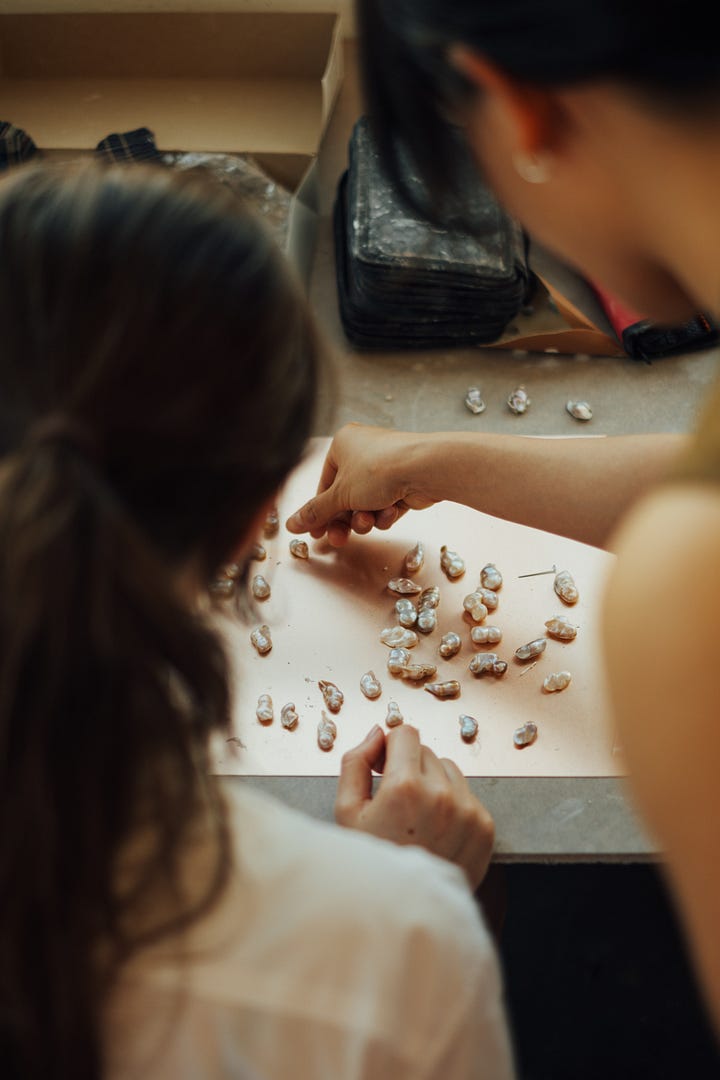
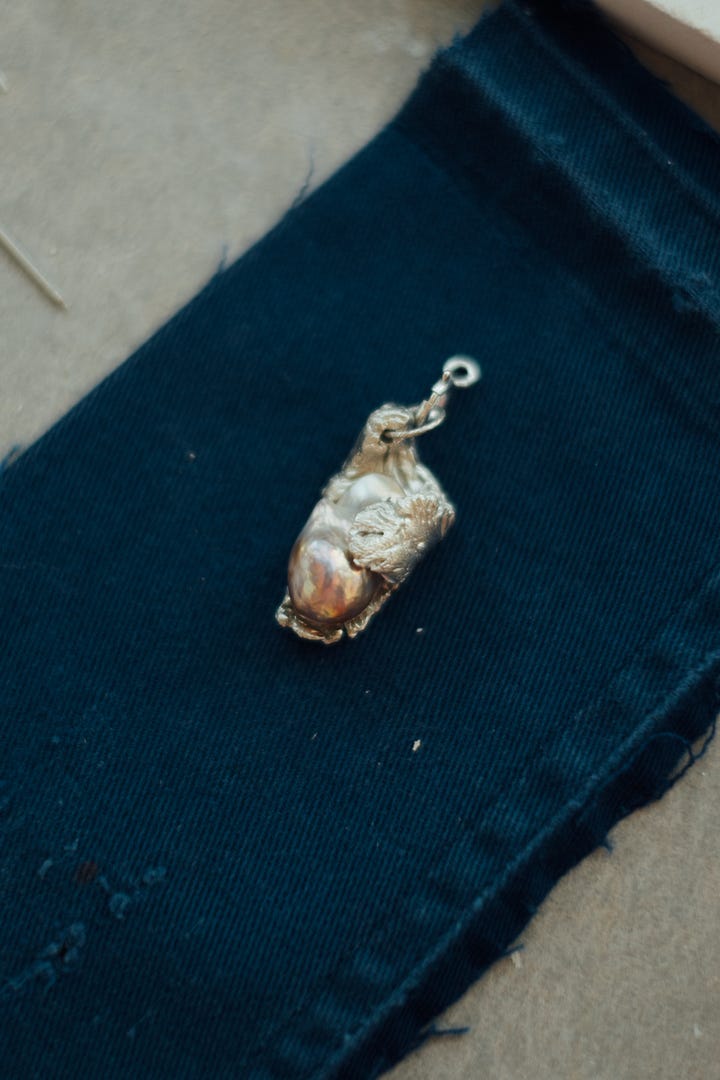
Nicki: The metal portion of each charm is made from a clay that has silver particles held together with an organic binder and water. When you fire — or in our case, torch — the dried clay, the binder burns off and the silver sinters together. I wanted the silver to act similarly to the plaster fragments — an impression of the body.
Nicki: Unlike traditional metal casting where you make a mold from a wax positive, the silver clay holds direct touch. There’s no intermediary between the final silver object and my hands. That intimacy felt very important for this project.
Joy: Yes, I remember how quickly you needed to work with the silver clay — as soon as it was out of its package, it started drying. Watching you work with it was kind of like watching a conversation (or in some cases, an argument) unfold — it glued itself to your hands, you prodded and pressed at it with various tools — you both had to communicate quickly and deftly to negotiate each shape.
Joy: Both the peculiar, embarrassing beauty of the blister pearls and the impatient, direct form of the silver clay felt very aligned with the spirit of the poems that Shaina has written for this season of Chores (more on that later). The poems are so much about the awkward yet earnest work that we do in friendship to help each other feel more comfortable with who we are — the messy process behind love and compassion and de-shaming and self-acceptance etc. I love how the physical intimacy of the charms allude to the emotional intimacy that inspired them. Do you have a favorite poem from this collection?
Nicki: It was never our fault really speaks to that!

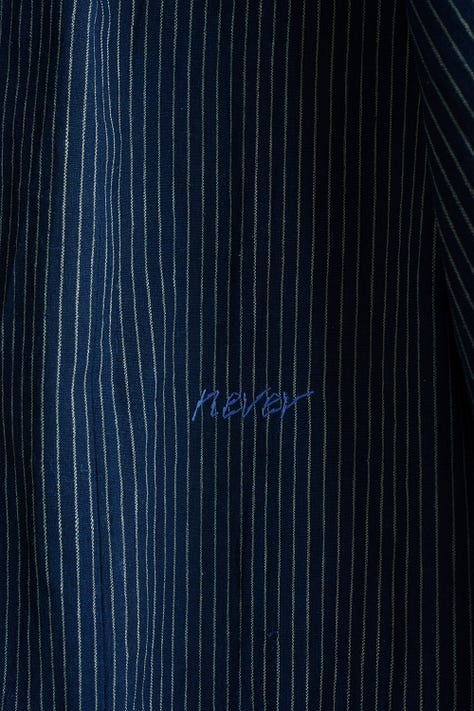
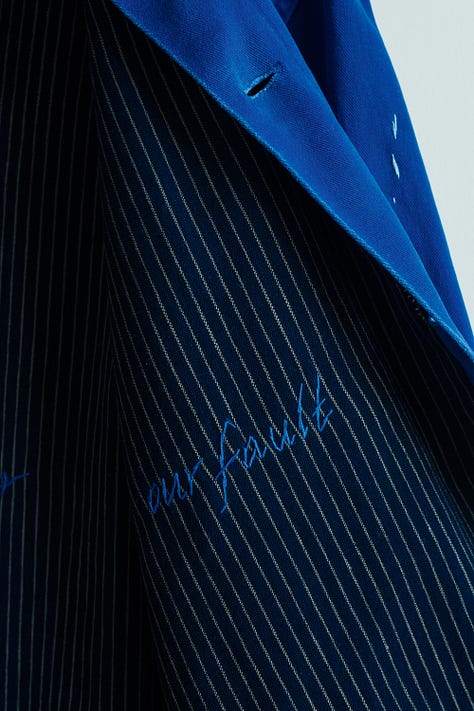
Nicki: Supporting a close friend going through a difficult time is very different from directly experiencing it yourself. You don’t feel the shame or guilt that so often accompanies trauma, you just want them to be okay. That empathy softens our shells and softly urges us to be more gentle with ourselves.
Nicki: One of the first times I felt really connected to you was seeing your reaction to my pet Madagascar hissing cockroach in college. Most people were super grossed out by him, or would just tell me he was a cool pet, but you looked at him with empathy. You saw his personality and individuality the same way that I did. It sounds sort of dumb, but I think there’s something full of transformative potential about holding so much love for such a small creature.
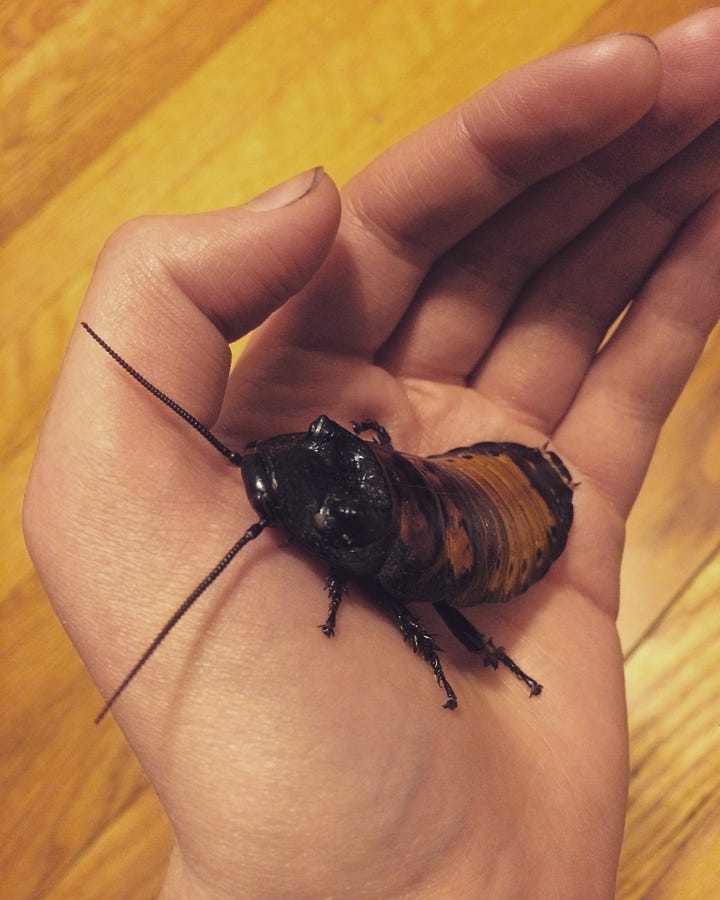

Joy: It’s not dumb at all, and definitely one of the things that made me feel connected to you too! I understood that your tenderness towards Roachbro didn’t have much to do with the fact that others found him gross — he wasn’t loveable to you because he was pitiful — you just saw a little guy who was full of sass and liked to dance. You’ve always held space for people (and cockroaches) to just exist as they are, appreciating all kinds of inherent goodness and believing in everyone’s right to life!
And I’ve always felt drawn to your work because it also offers this sort of observant and gentle yet radical acceptance, and I knew that you would imbue this energy into the charms for Chores. When people are out in the world wearing these pieces, how do you hope they will feel? What would you like them to remember?
Nicki: I hope that people are not too precious with them and really live in them! One of my favorite aspects about Chores — and your larger practice — is that these are everyday garments that you imbue with a lot of tenderness. All of the work that goes into each coat could only happen after the coats had lived a full life in the world. And now, after they have had this renewing relationship with you, they’ll continue to transform.
Nicki: Silver is a very difficult metal to keep “perfect.” If you want it to be super pure looking, you have to invest a lot of time and energy into regularly polishing it. I’ve been wearing one of the charms as a necklace daily over the past few months and it’s developed a patina from my sweat. It’s soaked in the memories of a particularly chaotic period of my life—showing abroad for the first time, saying goodbye to Chicago for the second time. And now the charm is absorbing the slowness of me piecing together a routine now that I am back fully in New York.
I hope those wearing a chore coat or charm feel the connection that comes out of sharing both the fast and slow moments in our lives.
Chores Collection 2, Season 2 will be available on joymao.com starting December 9th at 12pm EST.
Early access for my Substack subscribers — join us for the collection exhibition in Brooklyn:
Saturday, 12/7 ᐧ 2-6pm EST
Exhibition Open Hours
Info and RSVP here
Sunday, 12/8 ᐧ 11:30am-1:30pm EST
Artist Talk and Brunch
Info and RSVP here

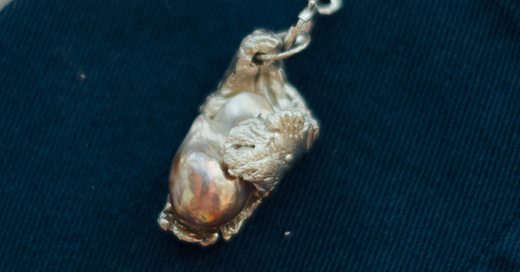


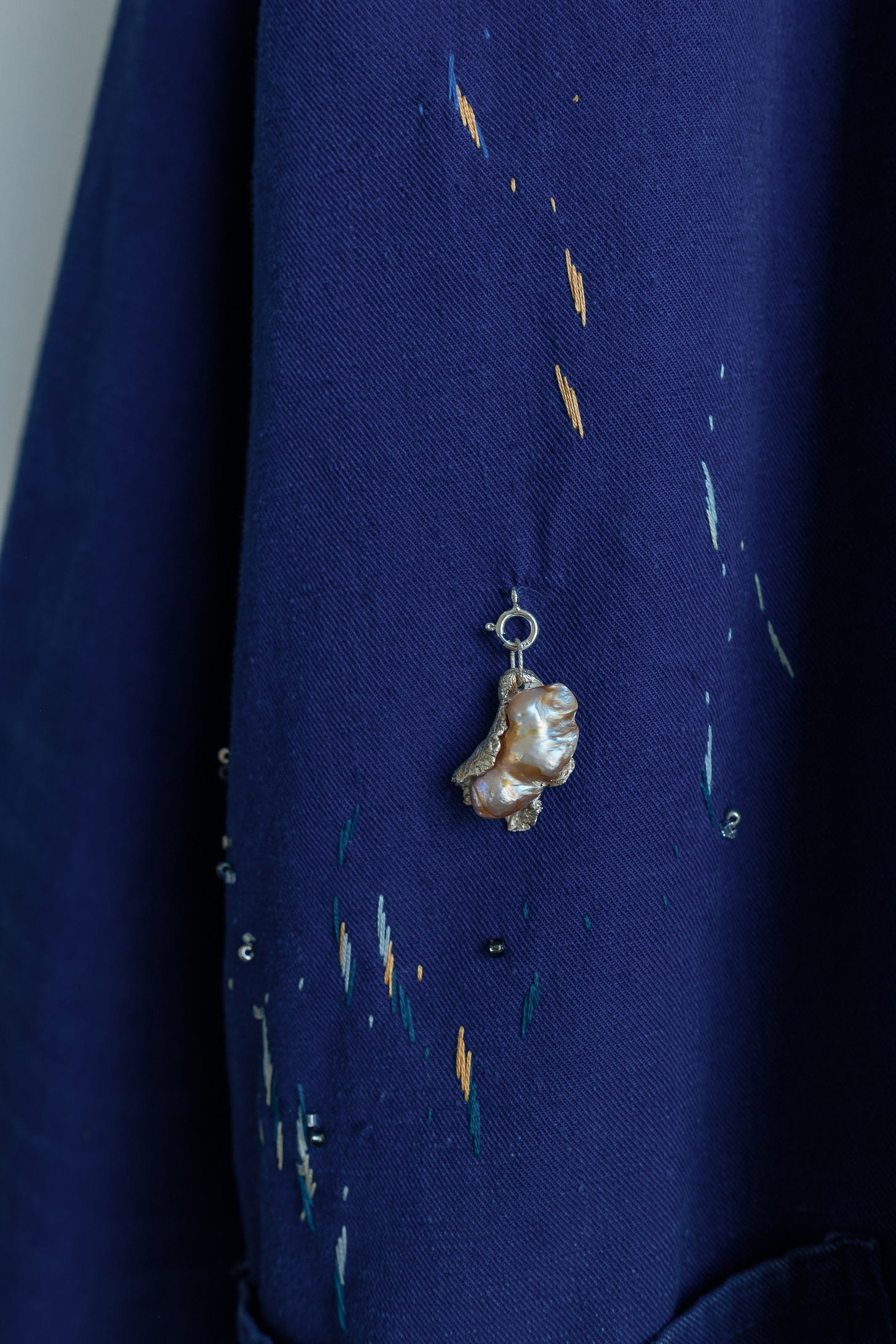
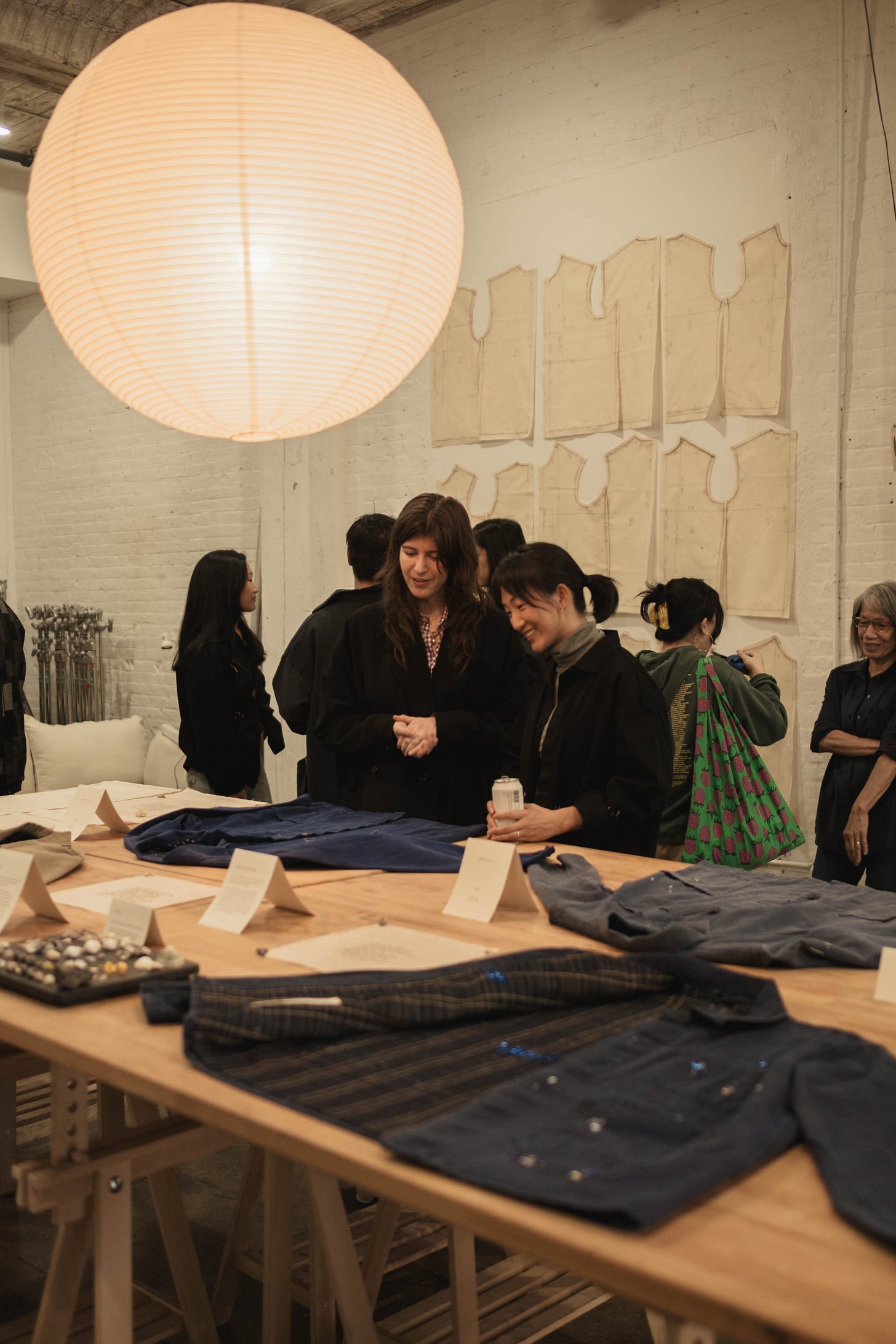
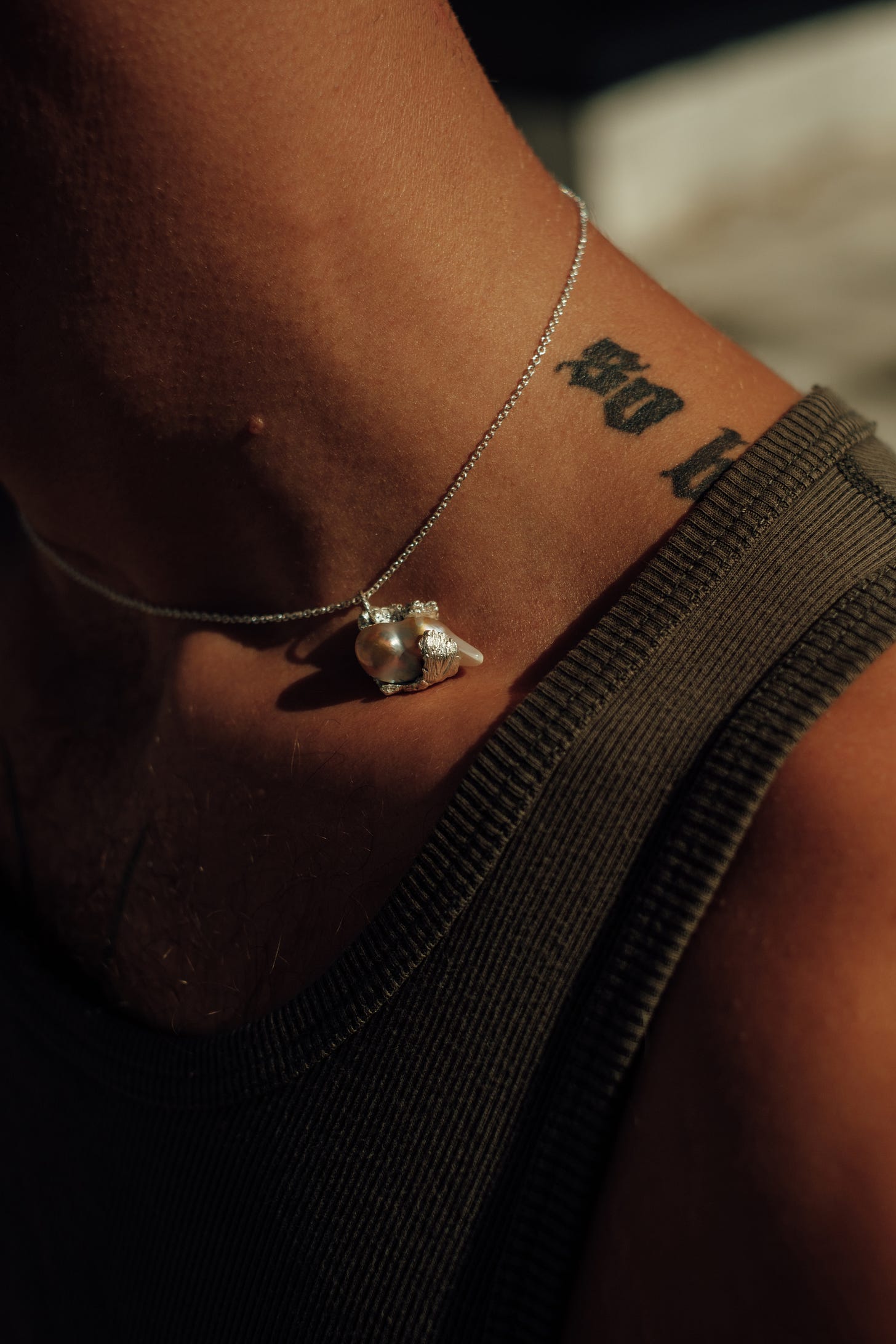


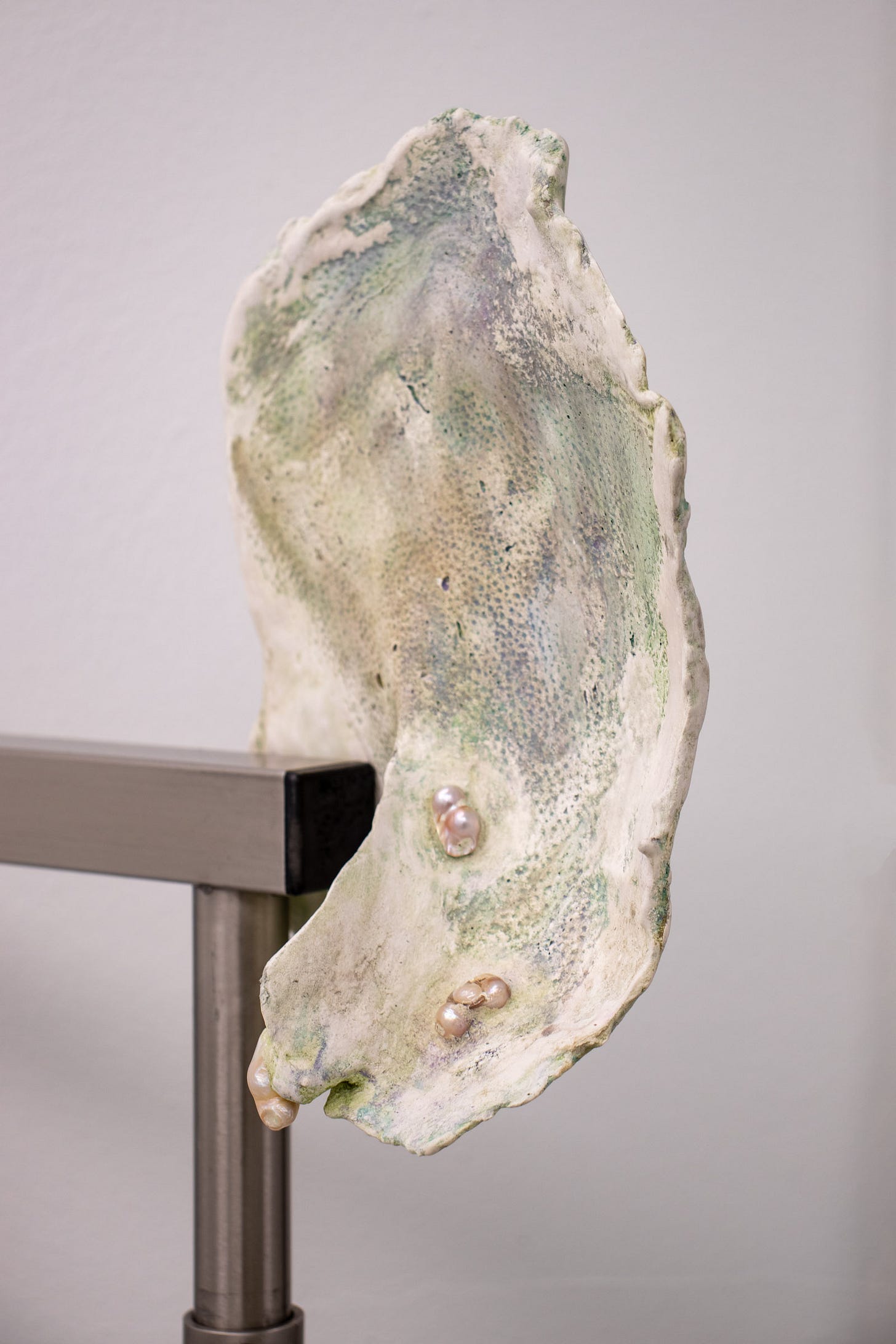





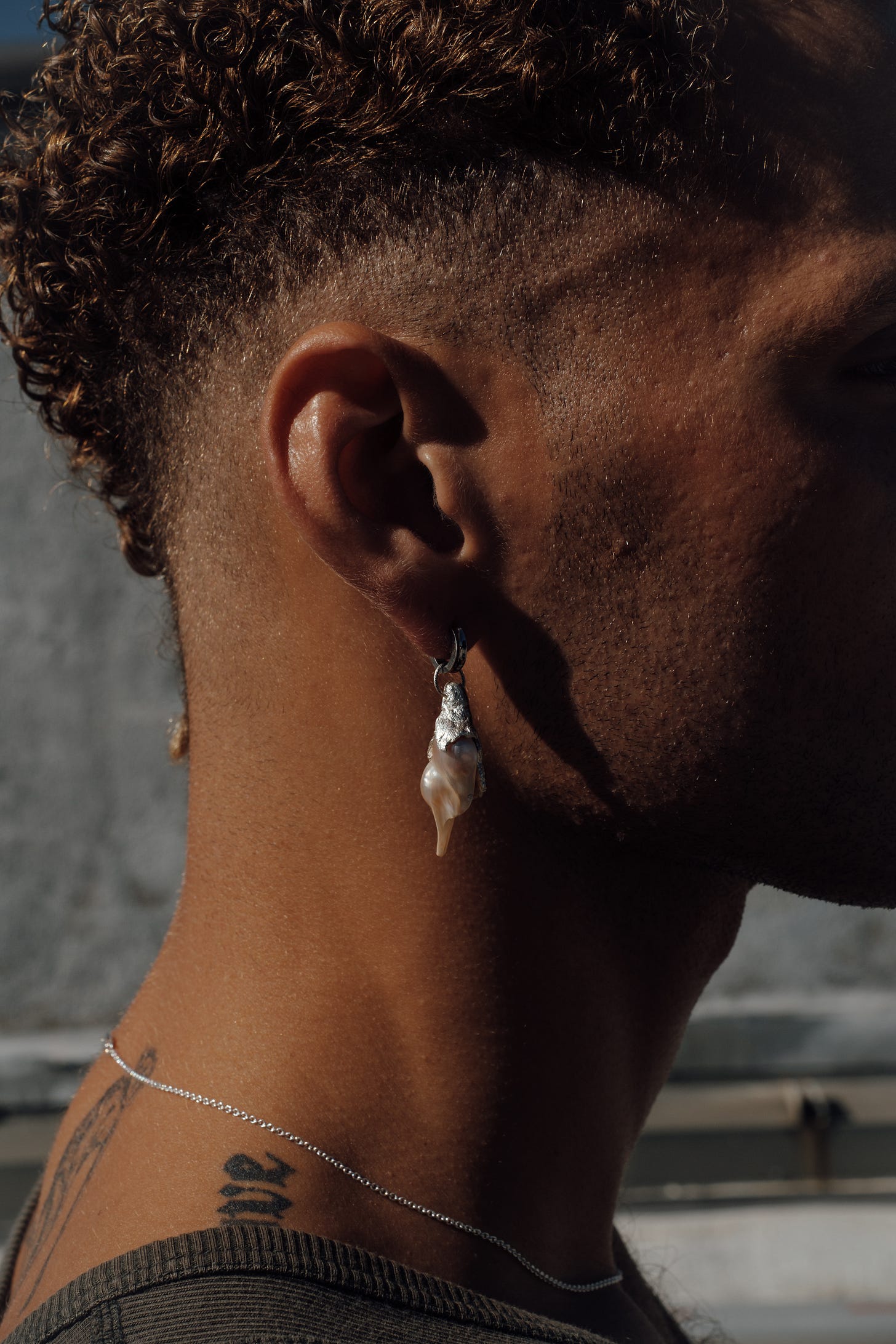
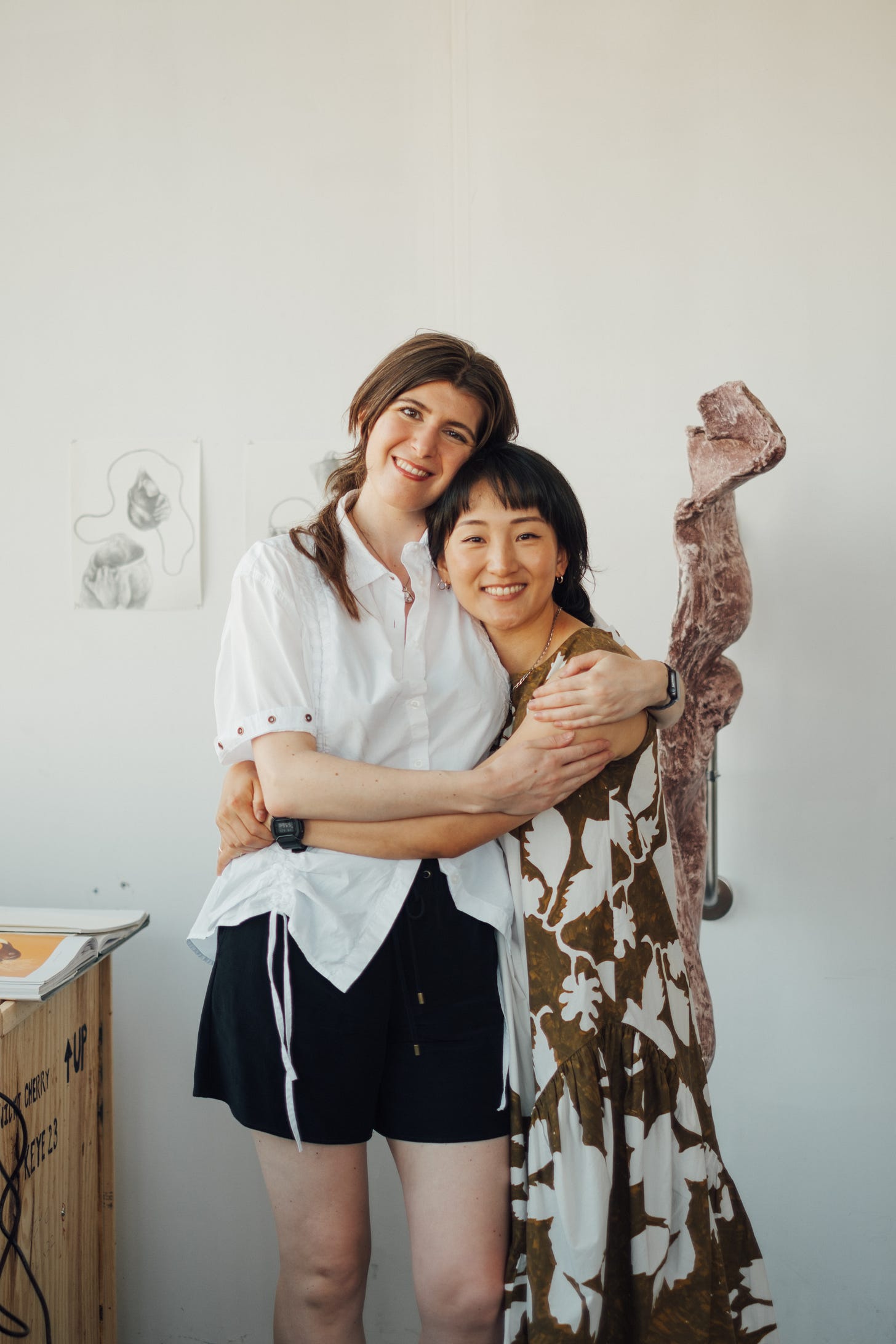
so evident how much intentional love and care is going into this collection (nothing new) but can especially feel the admiration you both have for each other's process and approach 🥹 "Your work is so much about the body, and how it negotiates with the physical and emotional space around it." and the note on the imperfections of silver!